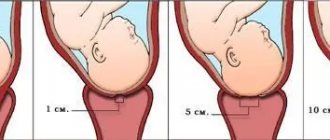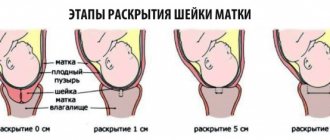How to speed up the dilatation of the cervix, stimulation, indications, types
Cervical dilatation is a fundamental moment in the process of childbirth.
The overall duration of labor, as well as the woman’s well-being, largely depends on the speed of its progress. Sometimes dilatation is slow and labor is delayed. This can cause serious complications during the birth process and the condition of the fetus.
Therefore, every woman needs to know how to speed up the dilatation of the cervix and how to determine that the process is proceeding normally.
Signs of the onset of labor
Every expectant mother is very worried about how she will understand that her baby is already coming towards her and labor has begun.
In all women, the onset of labor has similar symptoms and is accompanied by the following manifestations:
- Departure of amniotic fluid. This can happen with the onset of contractions or immediately as the baby passes through the birth canal. But if the waters break, then labor will occur in the next 12 hours;
- Regular contractions. The main difference between real contractions and false ones is their regularity, the gradual reduction of time intervals between them and pain;
- Dilation of the cervix, which occurs during contractions;
- Pushing activity and direct childbirth.
As a rule, women immediately understand that a trip to the perinatal center should not be postponed.
To correctly diagnose the onset of the process, you need to know the signs of cervical dilatation during pregnancy. This is one of the most accurate signals.
Indications for stimulating cervical dilatation
With the correct course of labor, the dilation of the cervix before childbirth occurs gradually. This process usually takes about 6-8 hours. For primiparous women it may be a little longer.
Sometimes the cervix does not open even in the presence of strong contractions. In this case, doctors begin to decide the question of how to open the cervix using stimulation.
The main indications for stimulating cervical dilatation and labor are:
- fetal hypoxia;
- a woman has a multiple pregnancy;
- the fact of postmaturity has been established;
- medical indications for the health of the expectant mother;
- abrupt cessation of contractions;
- the cervix does not open naturally;
- the period of contractions was too long and the woman was tired.
Who makes the decision on stimulation and on what basis?
The decision on the need to stimulate labor is made only by a doctor who directly monitors the process.
To do this, it must be established that further delay will only bring harm to the woman and baby.
Asking a doctor to stimulate without indication or doing it yourself is strictly prohibited. This can cause serious complications and even death.
Types of stimulation
Today, modern obstetric practice offers the following types of stimulation of cervical dilatation in a woman:
- medicinal;
- mechanical.
Medicinal methods of stimulating cervical dilation involve the introduction of special substances into the mother’s body, which provoke the process of dilatation.
Typically used for this:
- oxytocin - causes the uterus to actively contract and, therefore, open the cervix;
- prostaglandin - accelerates the process of ripening of cervical tissue and the beginning of the process of natural opening.
In addition to the injection, doctors may give you a pill to take or inject a gel directly onto the surface of the cervix. Their action is similar to the previous substances.
In addition to medicinal methods, mechanical methods are widely used. They include:
- stimulation of the cervix with a finger;
- using a special expander.
These methods open the cervix by direct mechanical action. They are quite painful, but effective.
Attention! The choice of method for stimulating cervical dilatation is chosen only by the doctor based on the general course of the delivery process.
Natural stimulation of opening
To avoid stimulation of cervical dilation directly during labor, you can speed up this process naturally.
Every expectant mother is concerned with the questions “How to determine the dilatation of the cervix on your own?” and “How can I open the cervix at home?”
If the appointed time has already passed, and the baby is in no hurry to be born, you can take the following measures:
- perform special exercises to dilate the cervix before childbirth:
- have active sex with your husband;
- do things that require physical activity.
You should not overuse these methods; sometimes the body is not ready and labor can begin quickly and at a time when it is a long way to get to the maternity hospital.
It is very important to know the symptoms that accompany cervical dilatation:
- tingling sensations in the cervix;
- severe aching pain in the lumbar region;
- vaginal pain.
If you notice such signs and symptoms in yourself, do not panic. You need to calmly collect all the necessary things, documents and go to the perinatal center.
Cervical dilatation is an important symptom during labor. It can be used to judge the correctness of the process, the woman’s condition and her ability to give birth on her own. The situation when the cervix does not open during childbirth occurs quite often.
Obstetric practice offers several options for stimulating the opening process, both in natural ways and with the help of special medications.
You should not refuse help or, on the contrary, ask for it at times when it is not needed.
In both cases, it can cause serious harm to mother and baby, sometimes causing death.
: what is labor induction
Source: https://kakrodit.ru/kak-uskorit-raskrytie-sheyki-matki/
Do I need to call?
At 39-40 and 40-41 weeks, a woman should have no reason to worry. If a pregnant woman at this stage turns to a doctor with a request to stimulate labor with medications, she will not be understood and the request will not be fulfilled. In order for labor to be complete, all stages of internal preparation for it must be completed naturally. Stimulation with medications in a maternity hospital occurs only in post-term pregnancy, after 42 weeks of pregnancy.
From the same position, doctors consider it inappropriate to try to speed up the process of childbirth at home. The fact that the expectant mother is very tired of carrying her precious child, that it is becoming increasingly difficult for her to walk, sit, and sleep, is understandable and arouses sympathy. But giving birth at the time provided by nature for a particular woman and her baby is the most optimal solution to the problem.
As you know, the ability to wait is one of the most difficult, and therefore women’s impatience and attempts to actively provoke childbirth can also be understood, but it can hardly be approved.
Before taking anything from grandma’s advice or advice from the Internet, a woman should be sure that she has no contraindications. The baby should be positioned correctly in the uterus, in a cephalic position.
There should be no placental abruption even in the anamnesis in the early stages. The amniotic sac should be intact and there should be no leakage of water. A woman’s blood pressure should be normal and her hormonal levels should be sufficient for labor to proceed normally. Agree, not a single pregnant woman can say with confidence that all these conditions are met in her body.
Exercises for an easier birth during pregnancy to help your cervix dilate faster
Childbirth is a complex physiological process that is stressful for every woman’s body. However, today there are a huge number of different techniques that help the expectant mother prepare for childbirth even at the stage of pregnancy. They not only reduce pain and help make labor faster, but also shorten the recovery period after it.
What happens to a woman's body during childbirth?
Childbirth is a painful process for a woman. When the time of birth comes, the baby's head begins to put pressure on the walls of the uterus, they stretch, as a result of which the cervix gradually opens.
With each contraction, the opening increases, and after the amniotic fluid is poured out and the cervix opens by 4–7 cm, the contractions of the uterus intensify. The baby will be able to “get out” of the womb only when the cervix is dilated by 7–10 cm.
Contractions and pushing help the baby to be born.
During delivery, conditions are created that promote irritation of the nerve endings of the uterus, which is how pain occurs. The source of pain is also the compression of blood vessels during uterine spasms and expulsion of the fetus, since they contain a huge number of nerve cells. Referred pain most often occurs in the lower abdomen, in the lower back, sacrum, hips and groin.
How to prepare your body for childbirth
You need to prepare for childbirth throughout your pregnancy. Special gymnastics helps to develop joint mobility, stretch the muscles of the thighs and keep the muscles of the perineum in good shape, which will allow a woman to make the birth process less painful. Also, exercises regularly performed by a pregnant woman speed up the postpartum recovery period.
Stretching exercises
Recommended exercises:
- Get on your knees and hands. As you inhale, bend your back, lifting your pelvis high.
- Sit in lotus position with your hands on your ankles. Leaning forward, press your elbows onto your knees. Repeat 5-6 times.
- Sit on the floor, straighten your back and cross your legs. As you exhale, turn around, trying to reach your chin to your shoulder.
- In a sitting position with straight legs, bend forward and try to reach your feet with your fingertips.
Exercises with fitball
Fitball has proven itself well in preparing pregnant women for childbirth. It helps strengthen the pelvic and abdominal muscles and is used to reduce pain during contractions. Every woman can do exercises with a fitball:
- Sit on the ball, raise your leg and hold it for 3 seconds. Change leg, repeat.
- Lie on the ball with your back and swing to the sides, strengthening the muscle corset of the back and abdomen.
- Press the fitball with your back against the wall and try to slowly sit down with it. The exercise relieves stress from the back, strengthens the muscles of the abs, buttocks, thighs and calves.
- Sit on the ball and swing in different directions, trying to maintain balance.
- Sit down, place the exercise ball between your knees and try to squeeze it as much as possible until you feel tired. Exercise allows you to strengthen your pelvic muscles.
Yoga for cervical dilatation
To induce labor, obstetricians may use oxytocin injections or a puncture of the membranes. If a woman wants to avoid this or seeks to facilitate childbirth, she can resort to special exercises from the arsenal of yoga. They can help the cervix open faster by stimulating labor. The following postures can cause contractions:
- cats;
- frogs;
- rocking mountains;
- crescent;
- deep squat.
Breathing exercises and breathing in the first and second stages of labor
An easy birth without proper breathing is impossible. To prepare, a pregnant woman should regularly do simple gymnastics:
- Lie on the floor with small soft cushions under your head and knees. Inhale deeply and exhale smoothly, simultaneously relaxing all muscles. Exercise saturates tissues with oxygen and helps relieve fatigue.
- Sit down and try to breathe “like a dog”: often, intermittently and for a long time.
To stimulate uterine contractions, a woman must breathe correctly: close her mouth and inhale deeply through her nose. Breathing exercises will help you learn this. If pain increases, it is recommended to use Dirga breathing: the first part of the inhalation is done from the lower abdomen, the second - from the diaphragm, the third - from the throat. Naturally, these breathing techniques need to be mastered in preparation for childbirth.
During childbirth, you need to practice different techniques:
- first inhale through your nose, hold the air, exhale through your mouth;
- to relieve contractions, sharp, shallow, equal inhalations and exhalations only through the nose or mouth (doggy breathing) are suitable to reduce pain;
- during pushing, at the command of the obstetrician, they inhale, hold their breath and push, as if directing air to the perineum, but in fact exhale at the end of the pushing;
- After the birth of the baby’s head, you need to breathe “like a dog” in the intervals between attempts, gaining strength.
Kegel exercises
Basic complex:
- slowly squeeze and relax the intimate muscles without using the muscles around the anus;
- quickly tense and relax the same muscles;
- squeeze the muscles, increasing the tension, as if climbing the floors - from weak compression to maximum, and then “descend” and completely relax.
To understand where the muscles of the perineum are located, it is enough to delay urination. When performing the complex, the load must be gradually increased, and before delivery, perform 3 sets of 20 times.
How to behave during childbirth so that it goes smoothly?
To reduce pain and speed up labor, a woman can behave actively: not lie down, but walk around the room, sit on a fitball, etc. The vertical position leads to relaxation of the pelvic floor muscles and increased pressure of the baby’s head on the cervix, which allows it to open faster .
If a woman prefers to lie down, she should avoid lying on her back - it is better to roll over on her side. To speed up delivery, you need to massage the abdominal and lower back areas with light movements.
It is important to remember that it is better not to scream during childbirth. Screaming contributes to muscle tension, slower cervical dilatation and fatigue of the woman in labor; it can lead to disruption of labor. For an easy birth, a woman needs to listen to doctors and follow their recommendations.
Source: https://www.OldLekar.ru/beremennost/povedenie/uprazhneniya-pered-rodami.html
Stimulation of labor
Childbirth is a complex and multifaceted process. For them to go well, you need to take into account a lot of nuances. Therefore, it is better to stimulate and accelerate this process under the supervision of a doctor or at least after consultation with him. Based on this, stimulation is possible at home and in the maternity hospital.
Initially, you need to be sure that the baby is ready to be born. To do this, you need to take into account the data of the last ultrasound and the duration of pregnancy. According to obstetricians, pregnancy lasts 40 weeks. Their months each last 28 days, so in terms of months, the woman is in position not for 9 months, but for 10. However, the last month, that is, from the 36th to the 40th week, is quite suitable for childbirth. A full-term pregnancy is considered from the 38th week. Therefore, before you are interested in how to speed up the birth process, you need to know exactly how long the baby is in the womb.
Physical exercises for opening the cervix before childbirth – myschool8.com
The uterus is the internal organ of a woman in which the fetus “lives” and develops during the nine months of pregnancy. For a better idea, it can be called a hollow sac consisting of muscles.
According to medical classification, the uterus is divided into the fundus, body and cervix. It is through the latter that the child is born. Let's talk about the dilation of the cervix during contractions and the birth process.
After all, if you know what to expect, then “giving birth is much easier.”
Preparing the cervix for childbirth
The mother's organs transform on their own for the upcoming birth of the child. At 39 weeks, signs of the cervix preparing for pregnancy sometimes do not appear. To prepare the dilatation of the cervix for these cases, special preparatory measures are required. This scenario is typical for the following cases:
- Post-maturity of the fetus in the womb;
- When the fetus begins to be born, the woman’s organs are not ready for maternity operations. Low elasticity predisposes the child and mother to injury;
- Due to medical necessity, the due date is artificially brought forward. Such measures are relevant in the presence of heart problems, gestosis, and signs of hypoxia in the fetus (oxygen starvation).
Summarizing
You now know how the cervix opens during childbirth. You also found out the peculiarities of the situation when the cervical canal is expanded to one finger.
Remember that if the cervix begins to open, infection of the fetus may occur. That is why you should avoid unprotected sexual intercourse, bathing and public bodies of water.
Visit your doctor more often and follow all appointments. Have a successful birth!
Archive of discussions of the “Parents Forum”.
Topic of discussion: When did the cervix begin to dilate and how long before birth?
According to the ultrasound, my due date is 39 weeks and 6 days; according to the last day of my period, 39 weeks. Yesterday I went to the doctor and was told that there was no dilatation of the cervix at all.
I’m curious about the statistics on dilation, who started when and how long it took before giving birth?
| QUOTE (Yana's mom @ Apr 12 2007, 10:41 AM) |
| Girls, I apologize for my own stupidity, I myself am at 38 weeks, but I don’t know anything about my dilation. How will they find out? during examination on a chair or by ultrasound? The fact is that my clinic is located on the other side of the city and the doctors and I decided that there was no need to come again for a consultation, but only to the maternity hospital. |
| QUOTE (Frega76 @ Sep 28 2007, 08:12 PM) |
| Hi all! I’m writing almost on the threshold (I’m going to the maternity hospital). Today I saw a doctor (dilatation 1 cm) for 40 weeks and 1 day, I asked for stimulation because the deadline had passed, he looked at me and called something with his hands.. I arrived home, very weak contractions started after 10 minutes, then after 5, water on place. I can’t say anything about the disclosure at the moment.. Good luck to everyone.. I’ll come back and write what and how. |
| QUOTE (Tatiana Nik @ Oct 31 2007, 06:01 PM) |
| Mine told me that everything was generally not bad, that “the neck is ripening” (.) what does that mean? A? Week 41 is coming to an end. |
| QUOTE (Nicole @ Apr 11 2007, 07:16 PM) |
| According to the ultrasound, my due date is 39 weeks and 6 days; according to the last day of my period, 39 weeks. Yesterday I went to the doctor and was told that there was no dilatation of the cervix at all. |
I’m curious about the statistics on dilation, who started when and how long it took before giving birth?
Ways to stimulate cervical ripening
Medical and folk helping methods are highlighted for the readiness of the cervix for the fetus to come out.
Medical methods include several options:
- Laminaria. The method involves introducing seaweed formed into a thin stick into the canal of the neck. Under the influence of high humidity of the organ, the organic material swells tens of times. The algae presses on the walls of the cervix, which brings the tissue to the required readiness. With such stimulation, pain appears below the navel, training contractions, and mucus discharge.
- A medical examination promotes the readiness of the canal, provoking expansion.
- Use of prostaglandin. This group of lipid physiologically active substances that regulate labor. In the mother's body, such substances can be released independently or introduced into the body artificially.
- Taking antispasmodics provokes softening of the tissues of the cervix. The use of such drugs and beta-blockers is rarely used in practice.
Intimate relationships
Intimate relationships have always been considered the most basic “recipe” for accelerating the onset of childbirth. And from a medical point of view, this makes a certain biological sense.
Firstly, sex with your beloved spouse helps relieve the tension that accumulates towards the end of pregnancy in the expectant mother . Intimate relationships are a way to escape from painful thoughts associated with upcoming events, physical and emotional relaxation, as well as pleasure with the release of hormones - endorphins, which suppress the effects of stress hormones.
note
Often, some doctors and psychologists associate a kind of delay before childbirth, when all the periods of pregnancy have passed, with stress, the release of stress hormones, which seem to “pinch” childbirth, slowing it down on a purely psychological level due to the subconscious fear of pain, the unknown, problems and complications. .
During intimate intimacy, the brain seems to “turn off” and its influence on the body too - this makes it possible for the mechanisms to trigger labor to work.
Secondly, a man’s sperm contains prostaglandins, substances that lead to softening of the cervical area, its maturation and preparation for childbirth. Gels for preparing the cervix for childbirth, which are used by doctors in the maternity hospital, have a similar mechanism, only their concentrations are higher, and the process of application itself is not as pleasant as sex with a spouse.
Thirdly, due to intimacy and orgasm, blood actively flows to the genitals and the uterus, it receives more oxygen and nutrition, the muscles increase their tone , which stimulates the contractile activity of the uterus. This can lead to the mucus plug being released, training contractions intensifying and turning into true contractions over several hours or days.
Source: https://MedLazaret.ru/rody/raskrytie-4-sm.html
What complications can there be?
Labor may be complicated by too weak contractions, as a result of which the condition of the uterus remains at the prenatal level. Typically, this occurs due to excess amniotic fluid volume and multiple pregnancies. When the uterus is overstretched, its tone decreases, as a result of which labor weakens and the cervix does not open well.
When entering a maternity hospital, every woman experiences serious stress, especially when this happens for the first time. And this is connected not only with the change from the usual environment of her home to a hospital one, but also with the fear of what awaits her, of the unknown, and various terms from doctors, incomprehensible to the expectant mother, only intensify the state of stress and anxiety.
Perhaps the first frightening term for a woman when examined by a doctor in a maternity hospital is “cervical dilatation,” because it is this indicator that determines the body’s readiness for childbirth.
It is important to understand the meaning of medical terms and indicators, since understanding what the doctor is talking about will allow the woman to feel calm and comfortable.
How to prepare yourself for childbirth (methods and recommendations)
Many who gave birth in maternity hospitals remember very well the categorical verdict of doctors after an examination before childbirth: the cervix is not open enough, we will stimulate it. And the expectant mother is perplexed: how can this be? The contractions are in full swing, the baby is definitely striving for the light, but her own body is preventing this process?! Can't be!
There are 2 reasons for this statement from doctors:
Unfortunately, despite technological progress and the introduction of all kinds of examinations for pregnant women, the preliminary date of birth is set 5-12 days earlier than it actually occurs. This introduces an additional (and UNNECESSARY) moment of tension for expectant mothers: the due date has already approached, but labor has not begun!
Full term birth is considered between 38 and 42 weeks of pregnancy, so - CALM DOWN. But very often doctors believe: “Everything after 40 weeks is subject to stimulation.” In addition, a certain time is already allocated for each woman in labor in the maternity hospital. Please, go to bed










